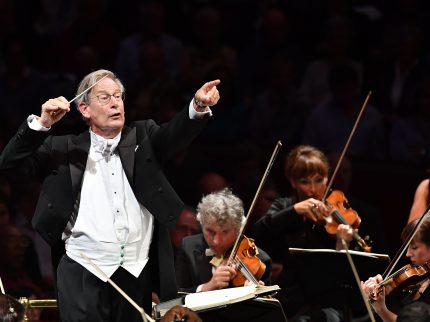Gardiner, ORR shed revelatory light on Beethoven symphonies

Beethoven’s nine symphonies are part of the bedrock of the orchestral repertoire. A season program without at least one of the nine is the exception rather than the rule, especially in this year celebrating the 250th anniversary of the composer’s birth. Given this abundance—perhaps overabundance—Beethoven’s iconic ennead can suffer from overfamiliarity.
Sir John Eliot Gardiner and his Orchestre Révolutionaire et Romantique (ORR), a period practice ensemble he founded in 1989, are providing a vital corrective to what can feel like the routine concert experience of hearing Beethoven’s symphonies. Gardiner and the ORR are traversing all nine scores over the course of five concerts at the Harris Theater. Judging by Saturday night’s performance, Gardiner and colleagues are revitalizing Beethoven’s watershed masterpieces in a thoughtful and dynamic fashion.
Saturday’s program was the middle of the five, offering Symphonies Nos. 2 and 3.
Symphony No. 2 in D Major, Op. 36, got off to a rough start with a jarring splat from one of the unwieldy valveless trumpets in the assertive opening gesture. Fortunately, this proved an isolated lapse in an otherwise pristine performance. Indeed, from the limpid wind lines of the opening bars, it was the different aesthetic of the period wind instruments that provided the evening’s greatest revelations.
The mechanics of wind instruments have changed to a far greater extent in the last 200 years than their string counterparts. While the advent of metal and synthetic gut strings were certainly significant advances for strings, wind instruments were refashioned in a more essential way. A period oboe is more like a large recorder with a reed that its modern equivalent, and the addition of valves to the brass family hugely increased those instruments’ flexibility. The timbre of the period woodwinds is also more piquant and how they respond to attacks more immediate than their modern counterparts.
This led to unexpected details of Beethoven’s Haydnesque score to be thrown into relief. Throughout slight variations in wind lines—usually buried in the more robust string sonorities of modern ensembles—made repeated iterations of the same material sound fresh in a way Beethoven surely intended.
Gardiner led a driven performance of the Second that emphasized these novel elements. His conducting was unobtrusive, but always maintained a sense of direction and highlighted the score’s nuances. The Allegro con brio was simultaneously fleet and forceful, with hugely effective juxtapositions of the softest and loudest dynamics, the vibrato-less strings lending the latter a thrilling declamatory quality.
The Larghetto was eloquently sung, again with the period instruments allowing for and creating different balances from what one frequently hears. Scherzo means “joke” in Italian, and Gardiner emphasized the humorous aspects of Beethoven’s off-kilter movement with guttural accents throughout, an assertive jettisoning of the until-then standard minuet. Period reed instruments are able to swell in a dramatic fashion, and this was on display in the bucolic Trio. The closing Allegro molto went at a breakneck clip, with darkly hued, robust fortissimos bringing the work to a close.
The ensuing “Eroica” performance was as revelatory as its D Major predecessor. Here the ORR’s violins and violas assumed standing positions, which presumably—like the rest of their practice—has some historic basis. Gardiner led a forceful reading that again elucidated many aspects of Beethoven’s landmark score.
The Allegro con brio went briskly and was particularly notable for the sweep of its crescendi; the dissonant outburst in the development was searing. Gardiner took the Marcia funebre as a quick tempo as well, avoiding the pitfall of the movement becoming a dirge and leading to a nervier reading of this desolate canvas. The valve-less horns made the Trio of the scintillating Scherzo sound all the more bucolic.
After the initial outburst that opens the final Allegro molto, Gardiner opted for the first variation to be played only by the principal strings, and the second by just the front desks. This added to the sense of progression and growth in the early part of the movement. The contrapuntal sections that follow had an unexpected clarity, and principal oboe Michael Niesemann was a standout in the reflective Adagio section. Gardiner led the fastest reading of the coda one is ever likely to hear—approaching the brink of playability, and ending an exhilarating night with an exclamation point.
Gardiner and the ORR continue their Beethoven cycle Monday with Symphonies Nos. 4 and 5, and conclude Tuesday with Symphonies 6 and 7. Both concerts take place 7:30 p.m. at the Harris Theater. harristheaterchicago.org
See New York Classical Review for reviews of other programs in Gardiner’s Beethoven cycle at Carnegie Hall.
Posted in Performances


